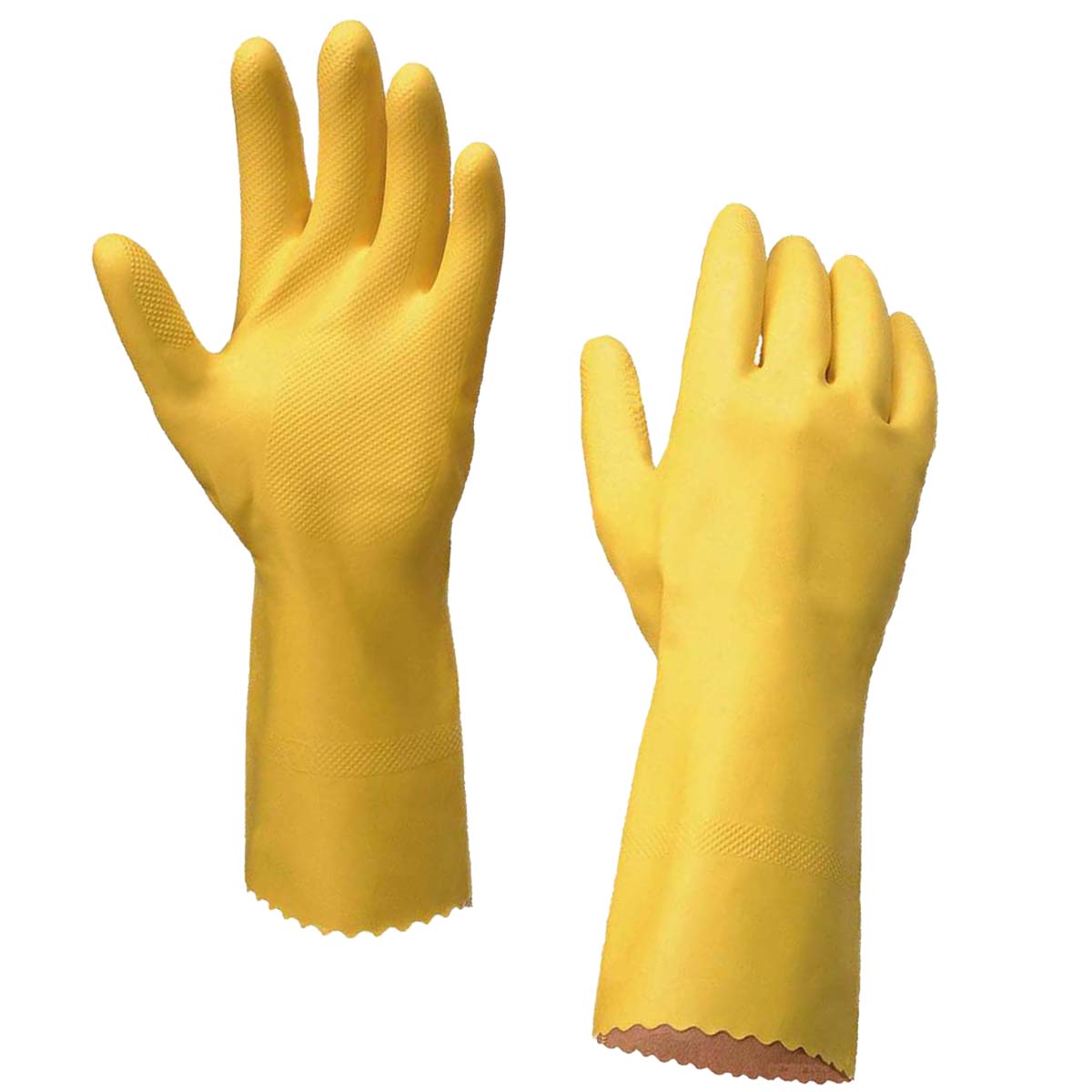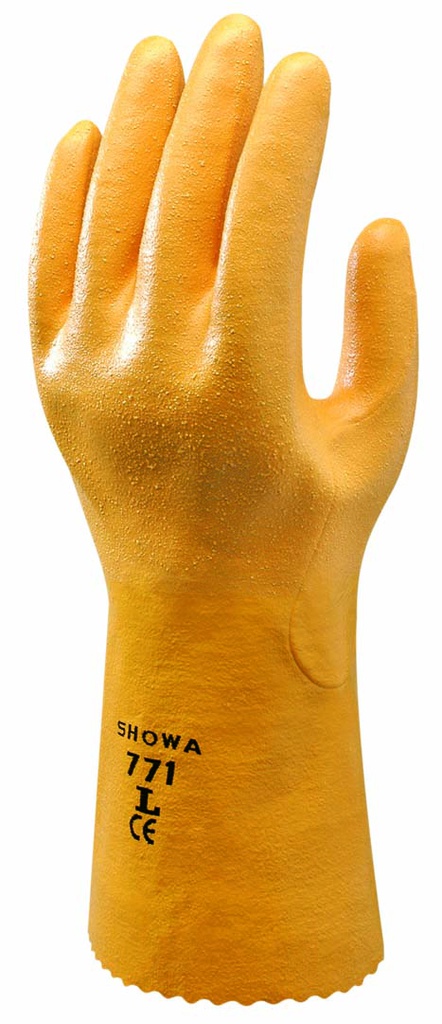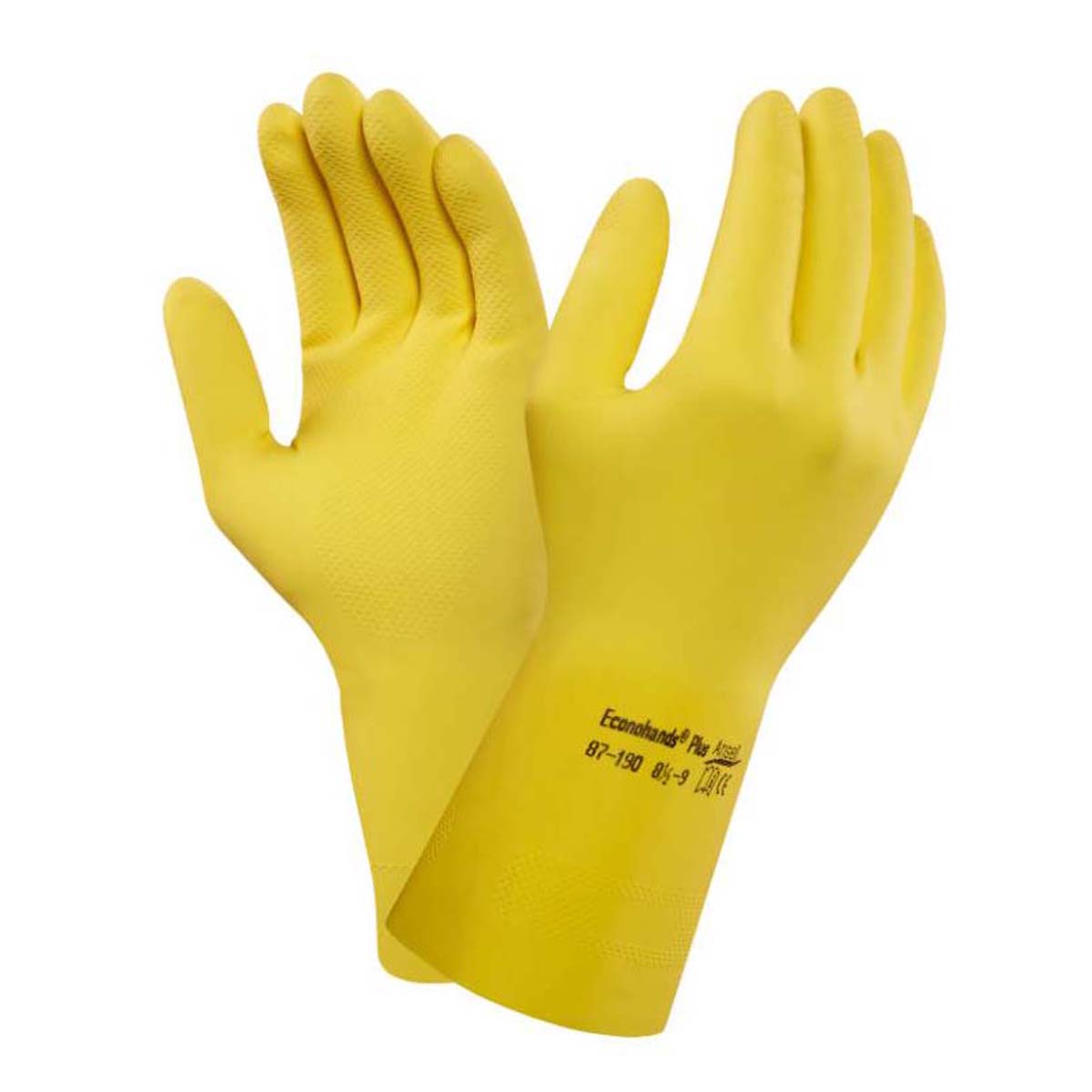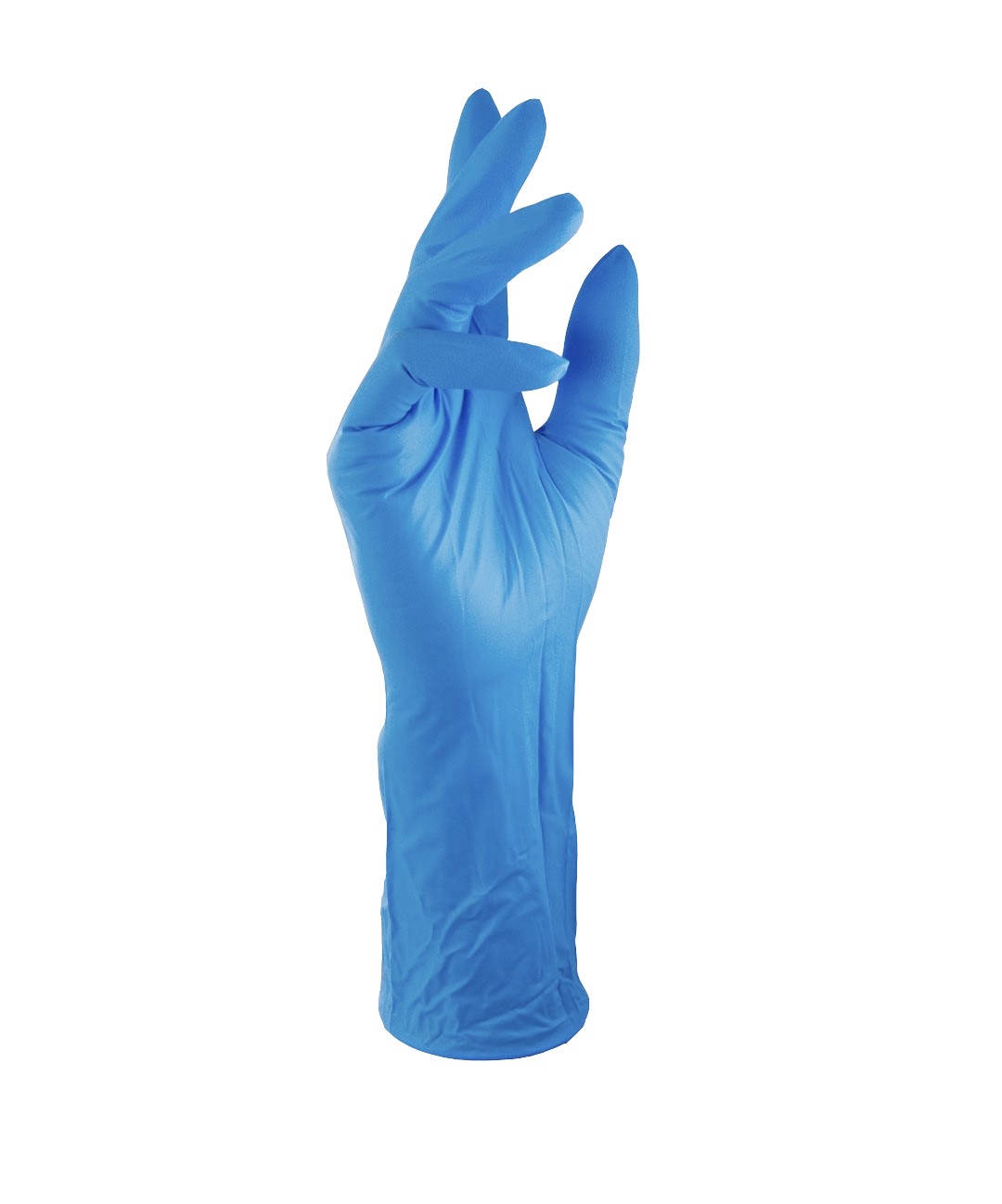Auswahlhilfe Handschuhe: Größen & Einsatzbereiche
Größe
Handumfang messen

| Handumfang in cm | < 17,5 | 17,5 – 19,0 | 19,0 – 21,5 | 21,5 – 23,5 | > 23,5 |
| Empfohlene DACH-Größe | XS | S | M | L | XL |
| Internationale Größe | XS | XS – S | S – M | M | L |
Einsatzbereich und Material
Material | Nitril | Latex (Naturlatex) | PVC/Vinyl | Neopren | Butyl |
Beschreibung | Nitrilkautschuk (NBR: Acrylnitril-Butadien Rubber) ist ein Copolymer aus zwei verschiedenen Grundbausteinen, Butadien und Acrylnitril. | Naturlatexkautschuk (NR: Natural Rubber) wird aus dem Milchsaft von Kautschukpflanzen gewonnen. Der Grundbaustein ist Isopren. | Ist ein Thermoplast und kein Elastomer. Durch Weichmacher wird das Material dehnbar, weich und biegsam. | Polychloropren (CR: Chloropren Rubber, Neopren) ist ein Synthesekautschuk, der durch das Chloratom eine höhere Ölbeständigkeit verglichen zu Latex hat. | Butylkautschuk (IR: Isobutyl-Isopren Rubber) hat als Grundbaustein das Isopren zum Großteil durch Isobutylen ersetzt. |
Eigenschaften |
|
|
|
|
|
Nachteile |
|
|
|
|
|
Chemikalie | Nitril | Latex (Naturlatex) | PVC/Vinyl | Neopren | Butyl |
| Fischöl | +++ | + | + | +++ | k.A. |
| Pflanzenöl | +++ | + | + | - | k.A. |
| Tierisches Öl | +++ | - | + | + | k.A. |
| Acetaldehyd | - | - | - | - | +++ |
| Aceton | - | - | - | - | +++ |
| Acrylsäure | - | - | - | - | +++ |
| Ameisensäure 10% | +++ | +++ | +++ | +++ | +++ |
| Ameisensäure 50% | + | + | +++ | +++ | +++ |
| Ameisensäure 90% | - | - | + | - | +++ |
| Amylalkohol | +++ | k.A. | k.A. | ++ | +++ |
| Calciumhydroxid | +++ | +++ | +++ | ++ | +++ |
| Dibutylphthalat | ++ | + | +++ | - | +++ |
| Dimethylformamid | - | - | - | - | +++ |
| Essigsäure 10% | ++ | +++ | +++ | +++ | +++ |
| Essigsäure 50% | - | ++ | +++ | +++ | +++ |
| Essigsäure 100% | - | - | + | - | +++ |
| Ethidiumbromid | +++ | ++ | +++ | +++ | +++ |
| Ethanol | - | - | - | + | +++ |
| Formaldehyd 37% | +++ | - | + | ++ | +++ |
| Glycerin | +++ | +++ | +++ | +++ | +++ |
| Isobutanol / Isobutylalkohol | +++ | - | - | +++ | +++ |
| Isopropanol / Isopropylalkohol | +++ | - | - | + | +++ |
| Kalilauge (Kaliumhydroxidlösung <50%) | +++ | +++ | +++ | +++ | +++ |
| Kresol | - | - | + | - | +++ |
| Methanol / Methylalkohol | - | - | - | + | +++ |
| Methylamin | + | - | + | ++ | +++ |
| Natriumhypochlorid (13% Chlor) | +++ | +++ | +++ | +++ | +++ |
| Natronlauge / Natriumhydroxid 10% | +++ | +++ | +++ | +++ | +++ |
| Natronlauge / Natriumhydroxid 50% | +++ | +++ | +++ | +++ | +++ |
| Octylalkohol / Octanol | +++ | - | - | +++ | +++ |
| Ölsäure | +++ | - | +++ | +++ | +++ |
| Oxalsäure | +++ | +++ | +++ | +++ | +++ |
| Phenol | - | - | + | ++ | +++ |
| Phosphorsäure | +++ | +++ | +++ | +++ | +++ |
| Propylalkohol / Propanol | +++ | - | - | + | +++ |
| Rizinusöl | +++ | +++ | +++ | +++ | +++ |
| Salpetersäure 10% | +++ | +++ | +++ | +++ | +++ |
| Salpetersäure 50% | - | +++ | +++ | +++ | +++ |
| Salzsäure 10% | +++ | +++ | +++ | +++ | +++ |
| Salzsäure 32% | +++ | ++ | +++ | +++ | +++ |
| Salzsäure 37% | +++ | + | +++ | +++ | +++ |
| Schwefelsäure bis 25% | +++ | +++ | +++ | +++ | +++ |
| Schwefelsäure 50% | +++ | - | +++ | +++ | +++ |
| Wasserstoffperoxid 3-30% | +++ | +++ | +++ | +++ | +++ |
| Wasserstoffperoxid 50% | +++ | +++ | - | - | +++ |
| Zitronensäure | +++ | +++ | +++ | +++ | +++ |
| Acrylamid | ++ | + | + | + | ++ |
| Ammoniumacetat | ++ | ++ | ++ | ++ | ++ |
| Butylalkohol | ++ | - | - | + | ++ |
| Chromsäure (10%) | ++ | + | +++ | + | ++ |
| Fluorwasserstoffsäure 10% (Flusssäure) | - | - | - | ++ | ++ |
| Glykolether | ++ | - | ++ | ++ | ++ |
| Benzin | ++ | - | - | - | + |
| Chromsäure (50%) | - | - | + | + | + |
| Ethylacetat/Essigester | - | - | - | - | + |
| Fluorwasserstoffsäure 40% (Flusssäure) | - | - | - | - | + |
| Methylethylketon | - | - | - | - | + |
| Salpetersäure 65% | - | - | + | + | + |
| Schwefelsäure 96% | - | - | - | - | + |
| Benzol | - | - | - | - | - |
| Butylacetat | - | - | - | - | - |
| Butylether | ++ | - | - | - | - |
| Chlorbenzol | - | - | - | - | - |
| Chlornaphthaline | - | - | - | - | - |
| Chloroform | - | - | - | - | - |
| Diethylamin | - | - | - | - | - |
| Diisobutylketon | +++ | - | - | - | - |
| Ethylether/Diethylether | - | - | - | - | - |
| Kerosin | +++ | - | - | - | - |
| Maschinenöl | +++ | - | ++ | + | - |
| Methylenbromid | - | - | - | - | - |
| Methylisobutylketon | - | - | - | - | - |
| Mineralöl/Heizöl | +++ | - | ++ | ++ | - |
| Salpetersäure 100% | - | - | - | - | - |
| Schweröl | +++ | - | - | - | - |
| Styrol | - | - | - | - | - |
| Tetrachlorethylen | ++ | - | - | - | - |
| Tetrachlormethan | - | - | - | - | - |
| Toluol | - | - | - | - | - |
| Trichlorethylen | - | - | - | - | - |
| Xylol | - | - | - | - | - |
Diese Tabelle stellt eine reine Orientierungshilfe dar und hat keinen Anspruch auf Vollständigkeit. Die Chemikalienbeständigkeit ist von zahlreichen Faktoren wie Temperatur, Kontaktdauer, Konzentration und Handschuhdicke abhängig. Wir empfehlen, für jeden Einsatzzweck einen Eignungstest durchzuführen. DACH Schutzbekleidung übernimmt keinerlei Verpflichtungen oder Haftungen im Zusammenhang mit den in dieser Tabelle gemachten Angaben.
Erläuterung
- Sehr gut geeignet +++
- Gut geeignet ++
- Bedingt geeignet +
- Nicht ratsam –
Zugehörige Produkte
Inhalt: 12 Paar (1,29 € / 1 Paar)
Inhalt: 10 Paar (2,35 € / 1 Paar)
Inhalt: 10 Paar (4,76 € / 1 Paar)
Inhalt: 12 Paar (1,09 € / 1 Paar)
Inhalt: 1000 Stück (0,02 € / 1 Stück)
Inhalt: 100 Stück (0,06 € / 1 Stück)





.jpg)

.jpg)
.jpg)








